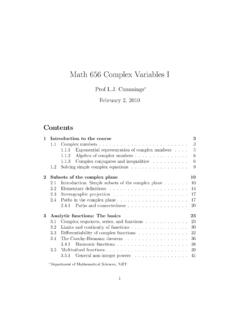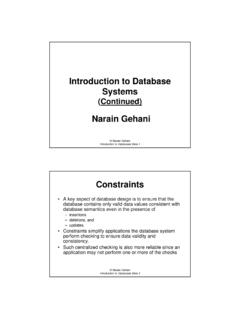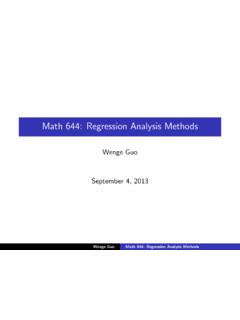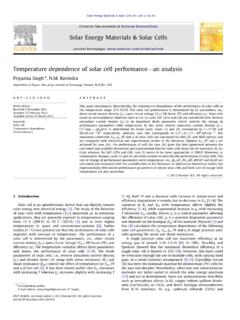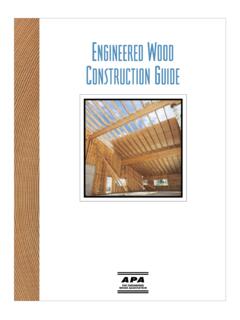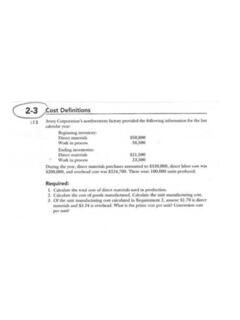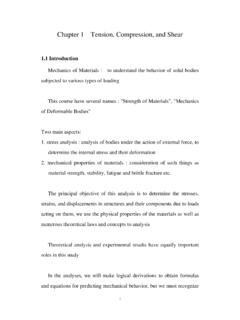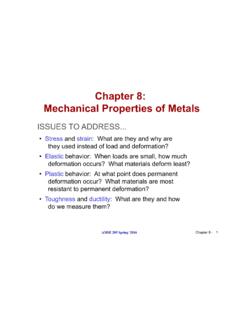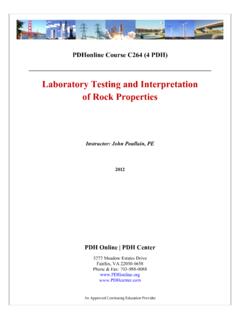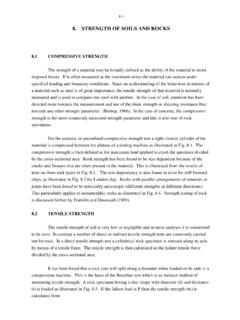Transcription of Chapter 2 Working Stress and Failure Theories A Simplified ...
1 Prof. Sengupta MET 301: Theories of Failure 1/9 Chapter 2 Working Stress and Failure Theories A Simplified Approach We are interested in learning how static mechanical Stress can cause Failure in machine parts. Static Stress means that the Stress has been applied slowly and is maintained at a steady level. Failure from cyclic (or dynamic) Stress and impact Stress will be treated later. Here, we should also keep in mind that, there are many other factors such as, surface wear damage from friction, overheating, chemical corrosion, metallurgical fault or a combination of these and other factors may also cause Failure . 1. Molecular Concept of Mechanical Failure Engineering materials have a crystalline molecular structure, which means the atoms (or molecules) of the material are arranged in a fairly ordered fashion and the atoms are held in fixed position with respect to each other by strong inter-atomic bond.
2 An external mechanical force tends to displace these atoms from their original positions in the direction of the force, which is resisted by the inter-atomic forces. Up to a certain limiting level of the external force, the atoms are displaced to some extent, but are pulled back to their original position when the external force is removed. This phenomenon gives rise to the elastic behavior of material (elastic deformation), that is up to a certain Stress level generally the displacement is proportional to force. Hook s law essentially is the same that is Stress is proportional to strain. If a force is applied parallel to an atomic plane (shear force) and the force is high enough, a plane of atoms may slide over the adjacent plane of atoms overcoming the inter-atomic forces of the immediately neighboring atoms.
3 When this sliding occurs, atoms in the sliding plane will slip under the influence of new set of atoms. Conceptual model of this slip deformation is shown in the diagram below. After the slip has occurred, the positions of the atoms have changed permanently, resulting in a permanent change in shape or size of the part. This type of permanent deformation is called plastic deformation. Plastic deformation is not acceptable in most mechanical design situations, because the permanently deformed part may no longer serve its intended purpose, and from the mechanical design stand point we may say that the part has failed. For example, a landing gear of an aircraft deforms elastically during landing from the ground reaction forces, but we certainly don t want it to be permanently (or plastically) deformed, because then the actuators or other mechanisms may not work properly during the next landing.
4 Prof. Sengupta MET 301: Theories of Failure 2/9 If a force applied normally across the atomic plane (tensile force) and the force is high enough, two adjacent planes of atoms may separate out from each other producing a crack. The initial crack will reduce the cross-sectional area of the load bearing surface, thus helping the crack to propagate until the entire surfaces separates from the inter-atomic plane. This type of Failure , which produces separation of atomic planes, is called fracture or rupture type Failure . Obviously this type of Failure will also not be acceptable in mechanical design. A conceptual model of fracture Failure is shown below. In macro scale, the materials are aggregate of randomly oriented grains. This means that the atomic planes in different grains are randomly oriented (see figure below).
5 The implication is that, the externally applied force may act as shear force or tensile force to different grains, depending on their orientation of atomic plane. As a result of this, the microstructure of a material can influence whether there will be slip or a crack from an externally applied force. Prof. Sengupta MET 301: Theories of Failure 3/9 2 Tensile test A tensile test, also known as uniaxial Stress test, is probably the most fundamental type of mechanical test that can be performed on material to determine its mechanical properties. Tensile tests are simple, relatively inexpensive, and fully standardized. As the material is being pulled apart, its strength, along with how much it will elongate can be easily determined. During this test, instead of plotting the force versus elongation, it is customary to plot the Stress versus strain, where Stress is force per unit area (P/A), and strain is elongation per unit length (dl/L).
6 Based on the total strain (or percent elongation) that a material undergoes before breaking into two pieces during tension test, engineering materials are divided into two distinct groups. Ductile materials are those that undergo larger strain (more than 5%) before breakage and brittle materials are those that breaks before any appreciable strain (less than 5%). During tension test, ductile materials remain elastic up to the Stress level of yield strength (Syp). That is, for the Stress level below Syp , the material will go back to its original length after the load is removed. Above Syp Stress level, the plastic deformation sets in, that is the material gets permanently deformed, which is unacceptable in mechanical design. During plastic deformation slip occurs between the atomic plains.
7 At a higher Stress level, known as ultimate strength (Su) the rupture of the specimen occurs, that is two atomic planes separate out from each other. Obviously, in the mechanical designing with ductile material, the limiting Stress level should be Syp. Another important characteristic of ductile materials is that the magnitudes of Syp in tension and in compression are very close to each other. That is for ductile materials, Syp in tension = Syp in compression. Majority of the commonly used structural metals, such as steel, brass, aluminum and their alloys are ductile material. Syp values for common engineering materials are found in Chapter 14 of the textbook. Stress strain characteristics for brittle materials are different in two ways. (1) They fail by rupturing (separation of atomic planes) at the ultimate Stress (Su) without any noticeable yielding (slip phenomena) before the rupture.
8 It can be presumed that Syp value of brittle material is greater than Su (2) Brittle materials are generally stronger in compression than in tension and consequently, for brittle materials Su in compression (Suc) is greater than Su in tension (Sut). As a result of this Suc and Sut are the limiting stresses in mechanical design with brittle Stress -strain diagram of ductile material Strain (dl/L) Stress (P/A) Syp Su >5% Strain (dl/L) Stress (P/A) Suc Sut In compression In tension Small % elongation before rupture Stress -strain diagram of brittle material Prof. Sengupta MET 301: Theories of Failure 4/9 materials. Examples of brittle materials are cast iron, concrete, cast glass etc. Suc and Sut values of different classes of Cast Iron s can be found in Chapter 14 of the textbook.
9 3. Engineering Stress and problem of predicting Failure In a mechanical part, we have seen that due to various types of external loading, a complex three-dimensional state of Stress can develop at a point. The most generalized state of Stress will have three normal ( x, y, z) and three shear stresses ( xy, yz, zx) at a point in three mutually perpendicular directions. The value of each of these six Stress components can be negative, zero or positive. Because a specific state of Stress can affect the material quite differently than the Stress applied in tension test described in section 2 above, the limiting Stress levels (Syp or Su) determined from tension test may not be directly applicable when a complex state of Stress exists. A conceptual model based on the atomic structure can explain this effect for complex Stress in influencing the limiting Failure Stress .
10 For example in if a compressive Stress is applied in addition to a shear Stress , as shown below, it may take more shear Stress to slide an atomic plane over the neighboring atomic plane, as compared to the shear Stress in absence of the compressive Stress . This is so, because the compressive Stress is adding up with the inter-atomic bond forces and thus increases the resistance to slip. Alternatively, if a tensile Stress is applied with shear Stress , the slip may occur at a lower shear Stress . Thus, when the state of Stress is uniaxial tension or compression, the limiting Stress values from the tension/compression tests (which are widely published in material handbooks) can be used. But for complex state of stresses, predicting Failure is not straightforward.


